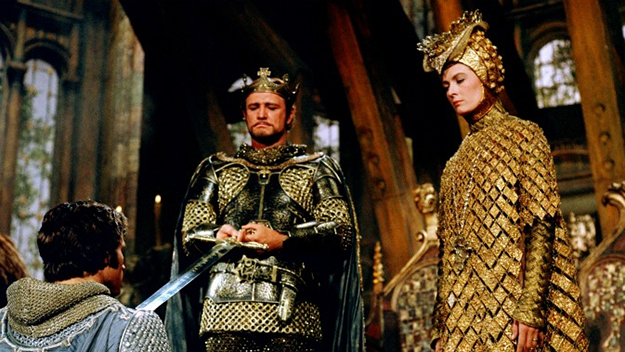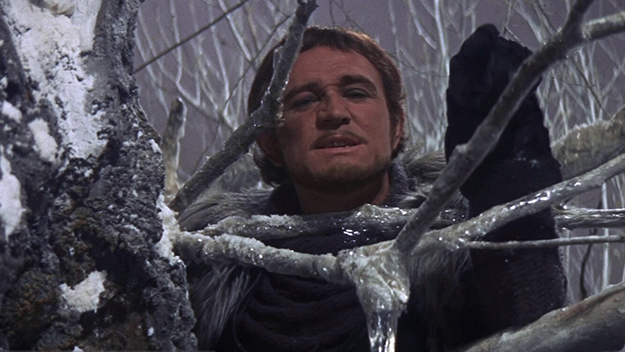For anyone wondering how, in 1967, a film as revolutionary as Bonnie and Clyde managed to sneak past Jack Warner, the then-75-year-old head of Warner Brothers, Camelot provides, if not an answer, at least a partial explanation: he had bigger things to worry about. Long before even a foot of film of this lumbering elephant of a musical had been shot, Warner Brothers had already spent more money on it than on the entirety of Bonnie and Clyde—including $2 million just to buy the rights to the 1960 Broadway show. A whole history has been written of how the overblown, too-costly roadshow movie musicals of the late 1960s—among them this film, Doctor Dolittle, Darling Lili, and Star!—killed the entire genre for years to come. But to grasp why Warner put so much effort into this misbegotten musical, one has to understand that when he set it in motion, he felt he was working from a foolproof, box-office-tested template. Like My Fair Lady, Camelot was a Lerner & Loewe show that had had a long Broadway run; like My Fair Lady, Warner had paid dearly to secure the rights from CBS (which produced both shows on Broadway); and like My Fair Lady, the studio had been sure that replacing an acclaimed stage star with another actor—in this case, Richard Burton was out and Richard Harris was in—would make no difference. In that, however, he was mistaken. Camelot was no My Fair Lady and never had been. The show itself was not even nominated for the Tony Award for Best Musical, but as King Arthur, Burton had carried it so effectively that he won the Tony for Best Actor. He wasn’t considered a top-tier movie star during the run of the show, but by the time Camelot the movie was released seven years later, he was—and would certainly have been a bigger draw in his signature role than Harris was. Camelot itself, however, was considered by many to be long and clumsy on stage—the show’s first preview in Toronto ran four and a half hours, and even the creative team knew that what they had pieced together was so ponderous that they continued to cut it long after it opened in New York.
The Broadway show’s Guinevere, Julie Andrews, had been passed over by Warner for 1964’s My Fair Lady only to become a huge star and an Oscar winner for Mary Poppins the same year. When Camelot was ready to shoot, her plate was full. So Warner placed a bet on a relative newcomer—Vanessa Redgrave. (By the time the film opened, she had won her first Oscar nomination for Morgan: A Suitable Case for Treatment, which, along with Blow-Up, had made her famous enough to be breathlessly described by Time magazine as “the skyscrapingest screen queen in filmsville.”) The studio gave its leading lady one of the last old-fashioned star rollouts, throwing an elaborate press luncheon to introduce her to four hundred journalists and inviting select reporters to the set, where one noted that she was “warm and natural with everyone…she never claims her star prerogatives except for the sake of someone else.” Which isn’t to say she was entirely pliable. Redgrave had already been arrested in four different political protests by the time she was cast in Camelot, and according to Joel Freeman, who served as the film’s associate producer, she initially refused to appear in a sequence featuring the Knights of the Round Table. “She said that bringing all the knights together from all over Europe was imperialistic,” Freeman recalled when I interviewed him in 2006. “But, I said to her, the whole idea of Camelot was imperialistic. She gave in, reluctantly.” Perhaps Redgrave had other things on her mind during the shoot. Separated from her husband, director Tony Richardson, she met and fell in love with her Lancelot, Franco Nero, beginning a decades-long on-again off-again relationship with him (they finally married in 2006). It’s Nero who provides the very few sparks the film offers; he brings romantic heat and a touch of wit to the film—two qualities otherwise in short supply. Camelot, with long stretches of dialogue punctuated by a mostly indifferent set of songs, many of which seem like My Fair Lady retreads, has always been a difficult musical to make work (none of its three Broadway revivals has lasted more than two months). And in the hands of director Joshua Logan, who positioned his singing actors on sets that looked like very expensive museum dioramas and costumed them in huge furs or immobilizing suits of armor, it’s even more leaden. The camera moves only grudgingly, as if at gunpoint. Logan’s palette has little joy or elegance: on mute, the film looks more like Becket or A Man for All Seasons than a film in which anyone would break into song, and with the sound on the tone careens from ponderous to romantic to campy (having the characters call each other “Lance” and “Jenny” doesn’t help). There are some problems that are built right into the show—its one semi-enduring ballad, “If Ever I Would Leave You,” doesn’t come up until Act Two on stage, which is almost two hours into the 180-minute movie—and others that are all the film’s own. History does not record whose idea it was to have Redgrave—who insisted on doing her own singing and whose voice barely asserts itself—being thrown in the air and walking on stilts while singing “The Lusty Month of May.”
Camelot was indifferently received by critics and got off to a discouragingly slow start with moviegoers; soon after its New York opening, Warner Brothers lopped out 30 minutes, cutting whole songs and stanzas of some others. The shorter version went on to become reasonably popular with audiences, though not enough to earn back its then-tremendous $17 million production budget (most 1967 studio films cost between $2 and $4 million). The film won three Academy Awards (for its more-is-more art direction and costume design and for its score adaptation), but it went unnominated in higher-profile categories, and was largely forgotten except as an unhappy near-end to Logan’s directing career (Paint Your Wagon, two years later, would be the last nail in the coffin). If there was a winner out of the movie, it was Harris. Life magazine may have dismissed him as a “great lump with I-beam shoulders,” but he knew he could own the role and, more than a decade later, he bought the stage rights to Camelot, toured in it extensively, and is said to have made a fortune. Mark Harris is the author of Pictures at a Revolution: Five Movies and the Birth of the New Hollywood (2008) and Five Came Back (2014).


